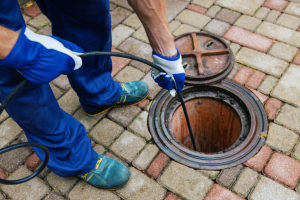 Sewer line clogs don’t usually happen overnight. Grease, tree roots, dirt, or old pipes generally block the line over time.
Sewer line clogs don’t usually happen overnight. Grease, tree roots, dirt, or old pipes generally block the line over time.
At first, drains might be slower than usual. But after a while, they can stop completely. When that happens, the wastewater will have nowhere to go, and it will start coming back into your house through your sinks, bathtubs, or your basement.
So, what should you do if this happens? This emergency plumber in Lake Forest, Illinois is going to answer that question below.
If you see water coming back up your drains, stop using water. The more water you send into the system, the more pressure builds up. And that extra pressure will make the backup worse.
Turn off your home’s main water supply if water comes up from more than one drain. It might be inside your house or outside near the water meter. This will stop more water from getting into your pipes and prevent the backup from spreading.
If you feel overwhelmed or confused about what to do, you should reach out to an emergency plumber in Lake Forest, Illinois.
Most homes have a sewer cleanout, which gives direct access to the main sewer line and makes it easier for a plumber to clear a clog.
The cleanout can be outside or inside. Outside, it is usually a capped pipe near your house or yard. It is generally made of white plastic or black metal and is about 3 to 6 inches wide. The cap might be marked with letters like “S” or “C.O.” or even the word “cleanout.”
Inside, it could be in the basement, utility room, or near a bathroom. Look for a pipe with a round, threaded cap. It is usually near a floor drain or where the main pipe leaves your house.
If you already know where your cleanout is and you feel comfortable, you can carefully unscrew the cap. This might release some of the pressure in the system. Sometimes, if the clog is near the cleanout, you can even see part of the blockage.
But be careful. If the clog is bad or the system is under pressure, wastewater might spill out. If you don’t know where your cleanout is or how to open it, it is safer to call a plumber.
If you have some plumbing experience and tools, you can try to clear the clog yourself. A plumber’s snake, also called an auger, is one of the best tools for this. It is a long, flexible cable that breaks up clogs inside pipes.
If the clog is deep or stubborn, plumbers will use hydro jetting instead. This is when they send a high-pressure stream of water through the pipes. It scrubs the inside of the pipes clean and clears away grease, food bits, mineral buildup, and roots. However, hydro jetting can damage old pipes, which is why a plumber always checks the pipes first to make sure they can handle it.
If you are not sure what to do or your pipes are old, it is better to call a plumber.
Once the clog is cleared, you can flush the system. Run hot water through your drains to clear any leftover debris. But only do this if you are sure the clog is gone. Because if not, the backup could happen again.
Once you have flushed the system, keep an eye on your drains, toilets, and yard. Look for slow draining, gurgling sounds, or standing water. These signs indicate that the problem could still be there.
Chemical drain cleaners are tempting, but they are not suited for sewer clogs. In fact, they can damage your pipes. It is better to keep up with regular maintenance to avoid future problems.
If water keeps backing up into more than one fixture, you smell sewage outside, or snaking the line does not solve the problem, call a plumber. A professional emergency plumber in Lake Forest, Illinois can inspect your sewer line, find the real problem, and fix it correctly.
If you are facing a sewer backup, water leak, or any other urgent plumbing issue, John J. Cahill Inc. is here to help. As the most trusted emergency plumber in Lake Forest, Illinois, we know how to handle these situations quickly and safely. Contact us anytime at 847-864-5225 for assistance.